Corsair joins Lincoln SUV realm
Filed under: Weekly test drives, Autos, Uncategorized
By John Gilbert
Two or three years ago, if Ford Motor Company eliminated its luxury Lincoln brand we might not have been surprised, because only the king-sized Navigator seemed to be successful for Lincoln, and it was basically a Ford Expedition with bling.
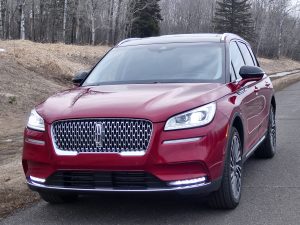
But in the space of one year, here we are evaluating — and praising — the third of three Lincoln SUVs all of which have carved out prominent places in the hierarchy of U.S. luxury sports-utility vehicles.
The new Navigator was deserving of high praise, and it was followed, barely a month ago, by a review of the entirely new Aviator, which I declared might be the best of U.S. luxury SUVs with its exceptional 3-row luxury as well as performance, tucked inside an extremely stylish exterior. And now, along comes the Corsair — Lincoln’s stylish example of what a compact, 2-row SUV can be, when a company puts its unrestricted mind to it.
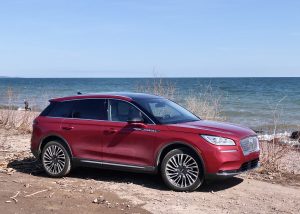
As someone who tries to be as objective as possible in evaluating any and all new vehicles, I had to admit the Navigator was bigger and heftier than I would choose, but its upscale luxury features made me realize why high-buck buyers would be drawn to it. The Aviator came wrapped in sheet metal that was attractively styled and the interior was loaded to the hilt with luxury pieces that made it expensive, but reasonably compact for a family that needed a 3-row SUV and still wanted something sporty and with surprising performance.
The Lincoln Corsair, on the other hand, fits like a glove my personal preferences for a compact SUV with adequate room for four or five and some baggage in its 2-row configuration, and it puts its tight and sleek styling to work in a sporty package that maneuvers easily, turns in a tight-circle u-turn, and will scat and run with the quickest of the compact SUVs. The competition is ferocious in the compact SUV realm, where Ford’s Escape is one of the standard bearers, and faces the likes of the Toyota RX4, Honda CR-V, Chevrolet Equinox, BMW X3 and numerous others, from virtually every manufacturer.
Since everybody seems to want an SUV these days, it makes sense that the majority of buyers might want to keep it compact when choosing, hoping to get improved fuel economy and making it easier to lure some performance out of smaller powertrains. The Corsair meets both ends of that bargain, delivering nearly 30 miles per gallon and still delivering some starch when you hit the gas.
Turbocharging is responsible for the compromise, with both Corsair engines, Ford’s 2.0 and 2.3-liter 4-cylinders gaining power from the forced-air feed of the turbos. The test-vehicle I drove was the loaded model, with a 2.3-liter turbo delivering a potent 295 horsepower and 310 foot-pounds of torque. That gives it about a one-second edge over the 2.0, with its 250 horses and 280 foot-pounds, in a 0-60 dash.

Taking a page out of Aviator’s book, the Corsair doesn’t have as flashy a dashboard design, but it does have similar bucket seats, with excellent support and 24-way power adjustability, with a curvaceous design that puts it up at the top of its class for comfort. The smooth leather seats have push-button heating and cooling ventilation, and add the therapeutic massage feature of its bigger siblings.
Lincolns have traditionally swiped the best features from Ford vehicles, and the Corsair wasn’t about to let the flashy new Escape get away with all its stuff, starting with its new and unique platform. The Corsair rides comfortably on the Escape chassis, which is firm in design which aids stability and sporty but safe handling. In its previous round of vehicles, Lincoln had the MKC sedan, which was nice, attractive, but was not an SUV.
The Corsair has the slightly taller stance and all-wheel drive, with all that high-end interior equipment and it is an SUV, retaining its flair for utility, even if compact and eye-catching.
One thing that takes a bit of getting used to is the shifter. Eliminating the console stalk to select gears gives occupants a bit more room, and Lincoln resists the temptation to go with the current and trendy norm of a rotating dial. Instead, on your first time inside and behind the wheel, you might spend a few minutes searching before you spot the location, just under the ledge of the center stack, where push buttons can activate reverse or drive or neutral to control the 8-speed automatic. Only problem, you can’t really see the buttons, so it helps if you know where they are.

If the front buckets are supremely comfortable, and encapsulate you as if in a cocoon, the rear seats will slide to add to the quite roomy comfort in the rear. And it helps all the seats that the sunroof is one of those full, panoramic roofs that seems to open the whole ceiling to the outside.
Both models of the Corsair offer all-wheel drive, with the more basic model starting at about $39,000 and the upgraded Reserve model starting at almost $46,000. My test vehicle came loaded up with nearly $15,000 in optional equipment and packages, reaching over $62,000, which maintains its $6,000-$8,000 price status above the base model.
Among all those upgrades are some serious luxury touches, such as LED lights for added brightness in every application. Headlights, taillights and foglights are all LEDs, and it even has what are called approach lights, which give you a little lighted grid on the ground outside the doors to make sure you realize you’re getting into the right vehicle.
I’ve always been an advocate of getting the smallest vehicle that is big enough, and the Corsair is the perfect example of what I was getting at. It will do everything larger SUVs will do, but with the added convenience of agility and maneuverability in traffic and congested driving.
As for the styling, the Corsair has a lot of cues from the larger Aviator, with that distinctive Lincoln grille fitted in between the headlight fixtures, and a side view featuring contour lines blending into the sheet metal on both sides, and large, stylish alloy wheels, with dual exhausts. A nice added touch on the rear is a horizontal taillight that runs the full width of the vehicle and makes a distinctive impression on anyone approaching from the rear, or coming upon a parked Corsair.
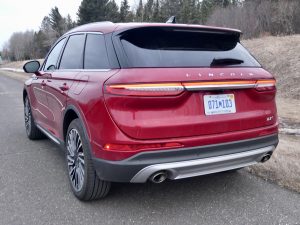
Built to slide, the rear seats offer comfort and added fold-down storage flexibility.
Maybe most people choose more compact SUVs because they cost less, but if things keep going the direction of the Corsair, we might have to start paying more to get all that styling into a smaller package.
Equinox gives Chevy a Premier compact SUV
Filed under: Weekly test drives, Features, Autos
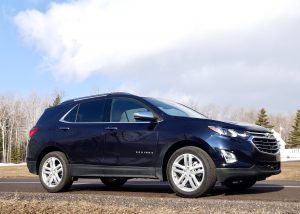
By John Gilbert
As the dreaded Coronavirus was about to foul up our springtime of 2020, I was just getting ready to enjoy the start of the NCHC college hockey playoffs, where the University of Minnesota Duluth was about to start its bid for a third straight NCAA title. I also had just finished a week-long road test with a 2020 Chevrolet Equinox Premier, a nicely styled and nicely sized SUV that is aimed at challenging the best of the compact SUVs — the RAV4, CR-V, Escape, Rogue, Cherokee, Tucson, Forester, and — my favorite — the Mazda CX-5.
Several things happened that caught me by surprise between my test drive week and the actual writing of this review. First, I was very impressed with everything about the Equinox, surprising because Chevrolet has seemed powerless to avoid fading away from the best of the rest. Second, I had read a couple reviews in car magazines, and my impressions of the previous Chevy SUVs and those test reports combined to make me apprehensive at best about the Equinox.
Another thing that happened was that the Federal Government has been very harsh — at least in its “Fearless Leader’s” dealings with General Motors. GM chief Mary Barra seems to have become one of President Trump’s favorite targets for his hit-and-run twitter/press briefing cheap-shots, dating back to his early days in office when he assumed all U.S. car-makers could simply shutter their overseas manufacturing plants and return to Detroit.
The most recent hit came after the last weekend in March, when the Coronavirus was tightening its deadly grip on all corners of the U.S., and Trump was live on television saying that GM had been dragging its feet when it came to aiding the nation, which was something he had become accustomed to in dealing with Barra.
It struck me as curious, because in the week before that outburst, I had read an account of how GM had worked out a partnership with Ventec Life Systems, a small company that makes ventilators, which have become so vital to helping afflicted patients keep breathing. GM engineers collaborated with Ventec on how they could convert a GM plant and find the materials to help Ventec make 10 times more than the 200 ventilators it normally makes each month.
In a matter of four days, the plan had been mobilized. And then Trump took his private little stage on Friday, March 27, 2020 and said he had activated an emergency plan that would force GM to help.
To their credit, although reportedly outraged, GM officials made the judicious move to keep on working around the clock to create ventilators without any comment on the accusation, and resisted making the link that Trump might have been hustling to attain his daily dose of praise, figuring if he hurried, he could take credit for forcing General Motors to start doing what it had already been doing for most of a week. Shortly after criticizing difficulties with GM “under Mary,” Trump cut off a daily press conference question about GM’s involvement and praised the company and its chairman for a “great job” of helping, stopping predictably short of apologizing for his awkward statement three days earlier.
Ford and FCA (Fiat Chrysler Automobiles), incidentally, also have been helping the cause. Ford, for example, has partnered with Minnesota’s 3M, and respirator-maker GE Healthcare, to simplify the process by which GE Healthcare can greatly increase its production of respirators, aiming at 100,000 per week.
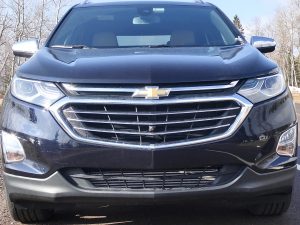
Meanwhile, back out on the road, I found the Equinox a far more worthy family hauler than a Motor Trend review of it indicated. Those car magazine hot-rodders tend to pound cars much harder than normal consumers might, so when they ripped the Equinox for not cornering like a Miata, I took it with a grain of salsa.
In testing a vehicle’s handling, what one driver might find too-soft in corner swaying is another driver’s comfortable ride; just like one driver’s firm and solid cornering might be another’s harsh and uncomfortable ride. The Equinox came in eighth and last in the Motor Trend comparison, but Chevrolet needn’t feel too bad; the magazine didn’t even bother to include a Ford Escape — another compact SUV I like a lot.
In the magazine’s test, the CR-V was first, the Mazda CX-5 second. Without question, the Equinox is no race car, although the magazine’s criticism of the car’s safety devices and poor-quality interior ingredients might be mostly due to the fact that it was not up to the standards of my test vehicle — which was the optional Premier, with its top-of-the-line features.
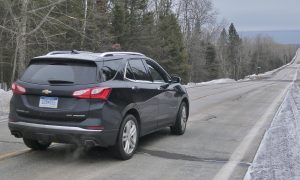
It was far better equipped to corner and display directional stability, and its numerous other interior and safety parts were much appreciated. The leather seats, lane-departure alert, lane-keep assist, rear-park assist and camera, heated and ventilated front buckets, heated steering wheel and adaptive cruise control are significant upgrades for a loaded, as-tested sticker of a reasonable $38,545.
Power in the test Equinox came from Chevrolet’s new-age 2.0-liter turbocharged 4-cylinder engine with a smooth-shifting 9-speed automatic transmission, while many competitors have a CVT (continuously variable transmission) that tends to drone and frustrate in equal parts. The 9-speed worked smoothly in coordination with the all-wheel drive in the Equinox.
The LED head and tail lights and the keyless start system are also nice things sometimes rare on compact SUVs.
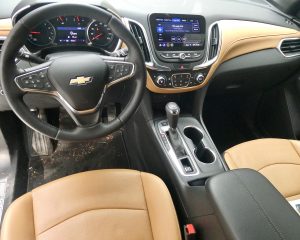
Each time I walked up to the Equinox, I was impressed by its styling, with its swept-back lines that blend the rear pillar into the rear of the vehicle. and I think it stands out from the pack because of that.
Chevy also makes the Traverse, which is a little bigger, but very similarly styled, with a V6 for power and three rows of seats. That makes it your choice: if you want and need a larger vehicle with a larger engine, or can get by with the agility of the smaller Equinox and appreciate improved economy. It was perfect timing that put the Equinox Premier with its push-button-activated all-wheel drive came into my hands at the precise time when it seemed that General Motors and Chevrolet needed and deserved some defending from unfair criticism from the White House, coupled with my impressions of the vehicle itself.
It has been a Chevrolet tradition when it makes cars to offer a top-of-the-line model, a mid-range model for features and expense, and a less-expensive bargain model that may be without a lot of appreciated features. Other companies cut corners similarly, but nobody else is guilty of stripping the true value items from its less-expensive models. That’s one area where the Japanese, Germans and Koreans are far ahead.

The Premier version of the Equinox matches most competitive compact SUVs, although the audio system was nothing special. It did have wireless charging for cell phones, and the optional OnStar system adds security. In its quest to load up remote switchgear on the steering wheel, though, I found that every time I cranked the steering wheel to get into or out of a parking spot, I inadvertently hit the little switch above the grip location and became conditioned to cancelling out the OnStar lady as she attempted to plan my rescue.
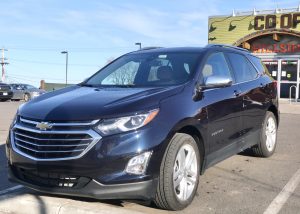
Over the weekend, various car dealerships hurting for sales came out with enormous ad campaigns. I caught a Chevrolet ad that screamed out about the 2020 Equinox being offered for 0-percent down, and 0-percent interest for 80 months, with the company paying the first four months-worth! That made the timing still better, because it seems as though Chevrolet is virtually giving away its Equinoxes.
Just remember, you may like it a lot or dislike it completely, but it all comes down to a driver’s opinion. And keep in mind that not all compact SUVs are created Equinox-ly.
Always room for bargain Jag-you-are
Filed under: Weekly test drives, Autos
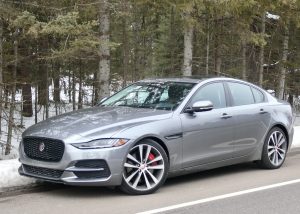
Ireland may be a long distance from Castle Bromwich, U.K., where the Jaguar XE is assembled, and maybe the Irish don’t always embrace the British, but when the week of St. Patrick’s Day coincides with the world closing up all our restaurants and pubs — and arenas, stadiums, movie theaters and other gathering places — for the Coronavirus pandemic in mid-March of 2020, we can still pause and give thanks, and hope, that there will always be a Jaguar.
We’ll even pronounce it “Jag-you-are,” as the British intended it to be, because, after all, they invented our language.
If you couldn’t go to a St. Patrick’s Day Parade, even, then maybe you could at least drive a Jaguar XE P250 S around for a while. Imagine it in a beautiful dark green — think traditional “British Racing Green,” but anything an Irish shade of green would work to celebrate.
Turns out, the test car I was able to drive before St. Patrick’s Day was a luxurious shade of “Eiger Grey” (with “grey” also being the preferred UK spelling) rather than green, but I could accept that, even though I happen to be about 75 percent Irish.
Times are tough in the auto selling business, all over the world, and Jaguar is among those hurting to sell more. But under the ownership of Tata Motors in India, the British pride is reflected in the newly restyled XE sedan, which I found dazzling to look at from every angle and to show off to anyone on my appointed rounds in and near Duluth, Minnesota. That includes the still-snowy and chilly North Shore of Lake Superior.
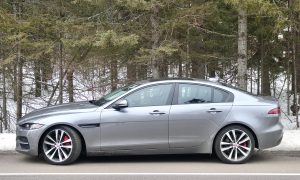
There are so many beautifully styled midsize sedans on the market that it is difficult to find any that aren’t, any more, which is a good thing. But Jaguars still hold a special place in the hearts and minds of car fanciers the world over, and the new XE stands out as one of the best bargains in the luxury sedan market. That may be the “glass-half-full” version, compared to those lead-footed critics who complain about the obvious drop in power from the previous supercharged V6.
When you do your first walk-around, and admire the formal grille, the gently curving lines on the sides, the sporty rear with its protruding exhaust tubes, keep in mind that this is a 4-door sedan, not a sports coupe. Consider the whole fleet of Jaguars, up to and including the larger XF sedan, which costs between $50,000 and $75,000, and he XJ, which runs from the mid-$70,000 range up and over $125,000, you have to guess that the slightly more compact Jaguar XE must cost somewhere over $50,000.
Surprise. The base Jag XE P250 S lists for $39,900, and everything comes equipped on the car, which means adding on the destination and delivery puts it up to a mere $40,895 sticker.
If you have always admired Jaguars, you will find that modest price a bargain. There are some places Jaguar has cut back on expenses. For one, the powerful, extravagant supercharged V6 has been discontinued, taking its voluptuous sound and its 380 horsepower with it. But Jaguar has countered very effectively, with a 2.0-liter 4-cylinder, turbocharged to develop 298 horsepower and 295 foot-pounds of torque.
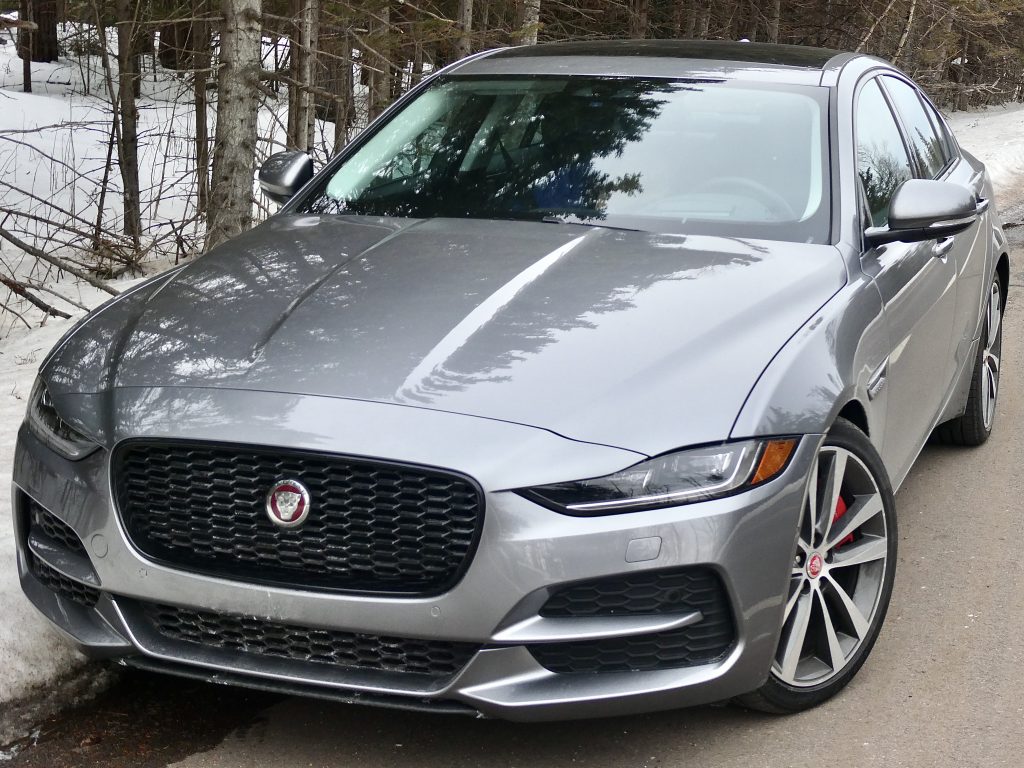
That’s a solid and impressive amount of power coming from a 2.0 engine, proving again how effective turbocharging can be to extract power from a diminutive batch of displacement. No, it’s not nearly 400, but in this era of economy, efficiency and expense — the “three E’s” of modern car-building, it is more than adequate. I’ve had experience with that engine before — as well as the supercharged V6 — in smaller models of Jaguar sibling Range Rover SUVs, where it handles all duties efficiently. So in the XE sedan, it dots all the right letters.
The powertrain earns extra points for the 8-speed ZF transmission that shifts smoothly and helps extract and apply that power. That powertrain used to come in two doses of power, with 247 horsepower in base form. but Jaguar wisely gives only the 296-horse version to the XE.
One place I do wish Jaguar had not compromised is that the XE comes in both rear-wheel drive and all-wheel drive, and the test vehicle had rear-drive only. In Minnesota winters, especially on Duluth hillsides, AWD is much preferred, and if you’re going to allow just two wheels to move your car, you’re best suited to having it be the front wheels, not the rears, which can defy all sorts of electronic traction, stability and other safety and steering gadgets to still enjoy trying to pass the fronts when you’re on ice.
Still, if you’re shopping for a Jaguar, the AWD option isn’t prohibitive in cost. And it probably doesn’t detract too much from the EPA estimated fuel economy of 34 miles per gallon in highway driving. Try that on your supercharged V6!
The week I drove the Jaguar XE sedan, we got lucky and were free of blizzards and nasty ice patches, which allowed us to get wherever we wanted with rear-derive, thanks more to Mother Nature than the Jag’s road-sticking tricks.
At $40,895, the XE hasn’t left much else unchecked when it comes to driving features, to enhance both sporty driving and the traditional feel of a luxury car, including something called JaguarDrive, selectable driving modes you can click from comfort to eco, to rain/snow, to dynamic, with dynamic holding revs longer and firming up your steering feel.
All the contemporary connectivity stuff is on board, whether Apple Car-Play, or Android, and you have the also obligatory safety features, such as rear camera, parking assist, blind-spot detection, and lane-departure warning as well as lane-keeping assist.

There is also All Surface Progress Control. You’ve got to love the Brits for coming up with their own name for trying to make their car hold the road. Progress Control? Never thought of that. It also has torque-vectoring, which uses computerized braking to correct your steering vector if the system senses that you are not tracing your projected curve judiciously enough to stay in your lane.
I also liked the ebony Windsor leather seats, and those impressive front buckets are heated and cooled and adjust 18 ways for both driver and passenger, to assure your comfort. That includes your ears, which are embraced by an 825-watt Meridian surround audio system.
Build quality of the XE is impressive, and the body that is now 75 percent aluminum intensive — or “al-you-MIN-ee-um” as the Brits call it — is aided by the lightness and strength of the alloy. Under those curvaceous lines there are exclusive 19-inch alloy wheels controlled by double-wishbone suspension in front and Integral Link in the rear. Double wishbone is simply the best, and you will believe it with the quick agility of the steering and the stability without jolts in any cornering attitude.
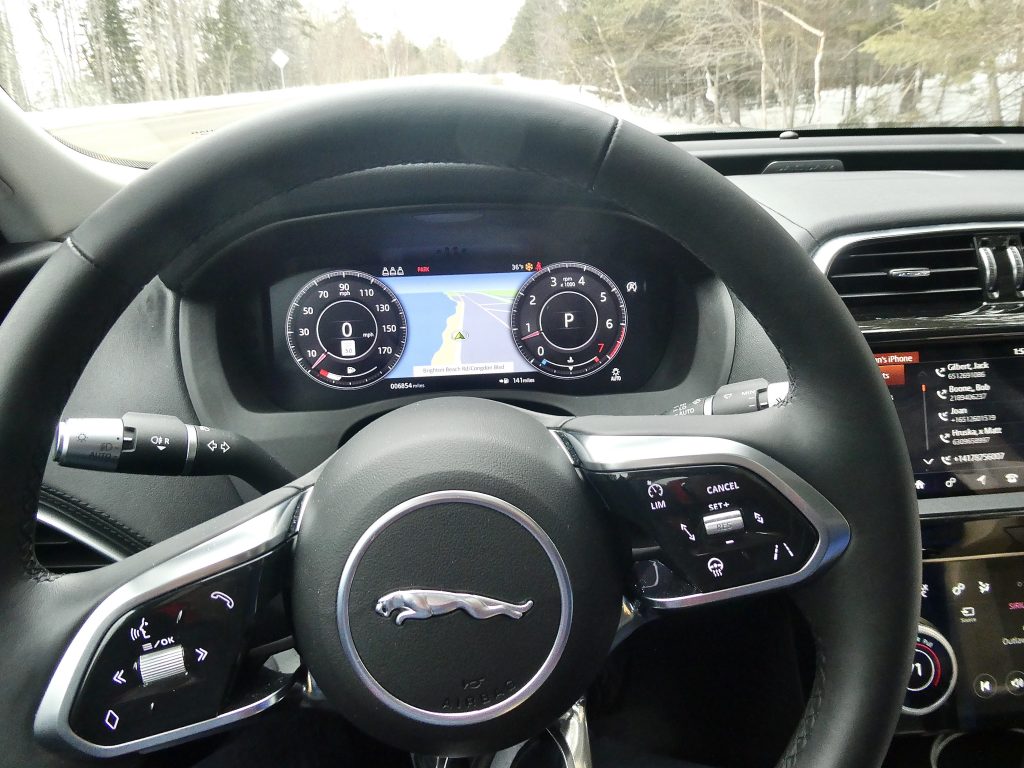
Inside, where you live after admiring your Jaguar XE upon approaching, the restyled exterior has been more than matched by the interior, where a new layout of instrumentation and fabrics cover every surface. Jaguar has even enhanced the 10-inch touch-screen by adding a redundant screen between the two large major instruments, the speedometer and tachometer, when you toggle up the assorted options to be located on your instrument panel. It is not as crisply sharp as Audi’s, which uses Google Maps for true satellite showings of your territory, but it is soft and artistic to view, and frees up the touch screen for other things that need touching.
LED headlights light up the night and have auto-dimming, the outside mirrors are heated against ice and frost, the rear seats are split to fold down, while an impressive ambient light show accents the inside and as you get in and out. A wireless charger is impressive, also a head-up display visible through your windshield.
The more I think about it, the more I’d like to see an XE in luck-o’-the-Irish green. Of course, we hope that this goofy worldwide virus afflicting us all will vanish just as swiftly as St. Patrick’s Day has come and gone. There will always be another St. Patrick’s Day, thankfully, just as there will always be a Jag-you-are.
Mercedes GLC 300 conquers new world
Filed under: Weekly test drives, Autos
By John Gilbert
The stereotypical image conjured up is of big, regal sedans or low, sleek sports sedans or roadsters, whenever the name Mercedes-Benz is mentioned. But it’s a new era, and while the Mercedes sedans and sports cars are sleeker and higher-tech than ever, the ideal vehicle for a changing world might be the GLC 300.
A year ago, Motor Trend named the GLC its SUV of the year, because the new vehicle was built up for a bit more interior room as a utility vehicle worth the name, combined with the sportiness demanded by contemporary drivers who want the extra panache of the Mercedes aura.
I got a chance to live with a 2020 Mercedes GLC 300 4Matic SUV for a week a while ago, and suddenly my memory came alive about why I decided I liked the small Mercedes SUV better than any of the fabulous cars from the Stuttgart specialists.
And that takes nothing away from the Mercedes cars, because how can anyone fault any of them? But as U.S. drivers prove their changing preferences with their checkbooks, Mercedes has a full batch of large and midsize SUVs for selection, and nestled in there, the company has placed the GLC.
The formula only makes sense. If buyers want the assets of front-wheel drive for maneuvering and handling in all weather, then why not trim the midsize model down to compact size, making sure there is adequate front and rear head and legroom, and storage space, then lighten it wherever possible and give it snappy, sporty handling and steering. Arm it with a high-performing but small engine, with a transmission that can make it sing, and maybe paddle shifters to allow sporty control of those shifts.
With that, here is the GLC 300, where the number doesn’t relate to the engine displacement the way it used to with Mercedes. In this case, the GLC has a 2.0-liter 4-cylinder with a turbocharger. The turbo is tuned to reach 255 peak horsepower and torque peaking at 271 foot-pounds. That may not sound like much if it were a big, bulky vehicle, but in the lean and mean GLC it’s plenty.
The 9-speed automatic can shift every well by itself, but also has those paddles to allow you to put it in the ratio you want for the situation. And with nine gears, it often might have shifted up too far too soon to give you toe-tapping torque when you need it. Paddle your left fingertip down a couple and you’ve downshifted from ninth to seventh for cruising down an exit ramp, and you can hold it in the lower gear with another couple flicks.
Up in the North Country, on the North Shore of Lake Superior, such controllable shifts are ideal for the packed snow ind slick ice that can cover the highways and hills. But I want to stress another feature of the GLC 300 that surprised me at first, then impressed me — a lot.
We were driving to the Chicago Auto Show, cruising in on Interstates through Milwaukee and then south to Chicago. I had set the destination for the hotel we had registered for, a Suite2 by Hilton, that was brand new and only a couple blocks by skyway from McCormick Place, where the show was. I wanted to skip the tollways that help Illinois folks pay for their highway repairs, even though I appreciate how smooth they are, compared to Minnesota’s frost-heaved pavement.
As we got right to the Chicago area, we had to swing in on the freeway to get to our destination, but ahead, we saw a fog-like greyness that was puzzling. As we got closer, we also saw all kinds of taillights and brake lights. It was snowing, causing the dusky grey, I got over into the right lane of the five lanes we were on, and we were amused that so many people seemed terrified of what we considered a light dusting of snow. And we kept our eye on the nav screen, where a neat diagram of all five lanes showed us exactly where we were and where we should be. I was right there, second lane from the right.
But traffic was thickening and stopping in some lanes as we approached an exit still 5 miles from our destination. Suddenly, my son Jack, my assistant, photographer, and co-pilot, said, “It’s telling us to exit here!”
At a glance, I saw he was right, with the solid blue line that was us, veering up that exit ramp. At a glance in the right side mirror, I realized we had a clear lane to our right, so I promptly swerved, and then swerved again to make it onto the exit ramp, smooth as if it had been planned. I was sure it was in error, but when we got up to the cross-street, we were greeted with flashing lights. A small accident had clogged the intersection a bit, but we were clear. I glanced one more time, and the nav screen did NOT say we should turn left, so having to decide in a millisecond, I continued straight across the street and back down the on-ramp.
As we entered back onto the congested freeway, I felt a little guilty that we had passed about 500 cars and easily merged back into the right traffic lane and continued smoothly to our destination.
Now, I would never suggest that anyone should drive that way, exiting and re-entering just to beat the system, but, hey! The nav lady told us to do it! After we got to our hotel, I started to wonder, and while I have no way to prove it, I believe the guidance system actually sized up the congestion and found a logical way to get around it.
Is that possible?
Well, whether intentional or not, we suddenly felt as though the feature-packed Mercedes GLC 300 had adopted us as its own.
Another surprise is that the sticker price shows $44,500 for the basic GLC 300, and adding virtually every available optional and safety package ran the price up to $60,575, it was still a bargain. The surprise to me was not that the vehicle cost $60-thou, but that you could get it for less than that if you took away some of the items, such as driver assistance, parking assistance, exterior lighting, or multimedia packages, and lower the price to nearly bargain proportions.
Included in those packages are a lot of impressive things, such as high-performance all-season tires, panoramic sunroof, active steering and distance control. active lane change, evasive steering assist, back-up camera with cross-traffic alert and warning.
In short, you can pretty much drive at ease, because your Mercedes is watching out for you. No, you can’t relax, and it doesn’t drive for you, but it allows you to focus on what’s really important on the road ahead, confident that the GLC 300 will alert your, guide you and maybe prevent you from any mistakes that might cause a problem.
And if it suggest you are convinced to exit ahead of plans, and find you’ve cut off about 20 minutes of congested driving, well, you can live with that.
Aviator flies high as top U.S. luxury SUV
Filed under: Weekly test drives, Autos
By John Gilbert
A good friend of mine, let’s call him Charley, had climbed the plateaus of journalism a few decades ago, and could afford the upscale family vehicle he had long craved. He wanted a midsize, luxury SUV, and he discussed his choices with me. After trying out several I recommended, he decided to buy a Lincoln Aviator.
Interesting choice, and not necessarily mine, but it checked all his boxes for being a cut above the more modest Ford Explorer, with some added features and classy appointments. Whenever I’d see him, he’d ask me about new vehicles I’d been test-driving, and then he’d tell me he still had his Aviator and loved it. I alerted him when the Aviator was discontinued, and when Lincoln itself seemed in jeopardy. Another decade has slipped past, and I’m not sure what Charley’s driving these days.
But when I see him next, I’m going to recommend the 2020 Lincoln Aviator in the strongest possible terms. The recalling of the old name on an all-new vehicle, on an all-new platform, stands for a lot more than just nostalgia, and if Charley liked the old one, he will love the new one.
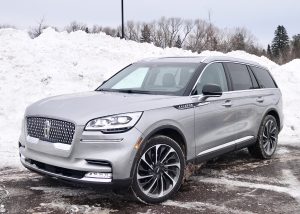
Far from a stereotypical pickup truck, the new Aviator radiates class even while confronting Minnesota snowpiles.
The Minneapolis-Saint Paul auto show runs through March 15 at the Minneapolis Convention Center. It’s an interesting year for the show, because it comes immediately after the huge Geneva Auto Show has been cancelled because of the worldwide threat of the Coronavirus and its warnings about avoiding major gatherings of people. We aren’t anticipating that major a threat in the U.S., but who knows? The upcoming New York Auto Show abruptly decided on March 10 to move its annual classic show to August 28-September 6, with media days August 26 and 27. Major pro sports teams are planning to eliminate crowds for the time being as well, but the Minneapolsi show goes on..
The Twin Cities show is attempting a made-for-U.S. specialty niche this year by putting on a “Truck Summit,” to explain and promote the nationwide swing to trucks over cars, which has reached amazing proportions in Minnesota, where reportedly 82 percent of sales are trucks or SUVs. The show will run through the first two weekends of March, and if you go, make it a point to check out the preponderance of trucks. In the process, you’ll notice the high level of sophistication in the interiors on virtually all manner of trucks.
Naturally, the array of Range Rovers sets a high standard for luxury appointments, and if you look closely at the SUVs in the Jaguar, Volvo, Mercedes, BMW, Audi, and Lexus — and even the new pickup trucks, particularly the Ram — it will not seem surprising anymore how much the price of those vehicles has increased.
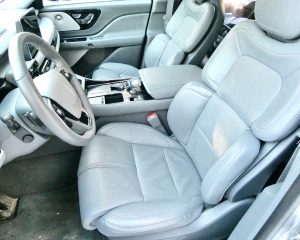
Difficult to say which is more impressive, the plush leather or the encapsulating comfort of the seat design.
But when you get to the Lincoln display, climb inside an Aviator. The first thing you notice is the rich leather bucket seat and how it encapsulates your body from head to knee. I’ve always praised Volvo for having the best seats in the industry, and maybe there’s a connection because Ford used to own Volvo, too. But the new Aviator bucket seats must now be ranked at the absolute top rung of any seat ratings.
There are something like 30 settings you can summon by switchgear to adjust your seat for optimum driving position. You can be excused, though, if you are tempted to stay in your parking space and take a short nap to fully take advantage of the comfort. Once you get the support right where you want it in the cushion, the lower back and the upper back, you can locate the switch that starts a massage process. It is a gently undulating thing, not the sort of massage to put you to sleep, but rather an invigorating stimulator that can enhance your awareness.
Base price of the Aviator Reserve with all-wheel drive is $58,700, but it’s difficult to resist some of the excellent options. The test vehicle had the luxury package, and options such as trailer towing, the sunroof, 22-inch machined alloy wheels, to augment blind-spot detection, evasive steering assist, auto high beams, active park assist, adaptive cruise, adaptive suspension, lane-keeping, drive mode selector, a 28-speaker Revel Ultima 3D audio, and readouts of posted speed limits on the dash or head-up display.
On top of all that, and the obligatory Sync3 navigation and connectivity items, a dynamic handling package aids stability and such features as a full rear console is handy between the rear buckets. All of that boosts the sticker price on the test Aviator to $76,310. That may seem outrageously high, but if you examine all that is included, and compare it to other top-shelf luxury SUVs and trucks, the Aviator appears to be worth the tariff.
The Aviator’s luxury starts long before you climb aboard, because the crisp contours of the accent sculpturing on both sides and the rear attract your attention and offer a pleasant aerodynamic appeal. From the front, the LED headlights, parking lights and foglights are all positioned in streamlined housings and surround the contemporary grille, which, thankfully, is understated in style and elegance. There are ingenious ways to turn the “puddle lights” and logo trim to make sure you remember what it is that you bought for a vehicle.
Opening the door on the test Aviator Reserve model, which was “silver radiance metallic” in color, avails you of the medium slate leather seats, which look much more than just inviting with their carefully crafted design. All the switches are within easy reach and have the anticipated redundant controls on the steering wheel. The console has room with the push-button shifter easy to get comfortable with. The sunroof is huge, and can let in a lot of sunshine even when closed for a winter day.
The large screen at the top of the center stack can carry several things at once. When you back up, you can summon the 360-degree surround view from up above to make sure there are no obstacles in the way of your movement. On top of the comfort and luxury, the Aviator drives easily, with stable cornering attitude and large doses of power for acceleration.
A 3.0-liter V6 is Eco-boosted to 400 horsepower and 415 foot-pounds of torque, programmed through a smooth-shifting 10-speed automatic transmission. The all-wheel-drive system is adjustable by modes for any type of driving, from blizzards to freeway cruising. It responds instantly to your throttle-foot input, although responding too eagerly can keep the fuel economy down around 17 or 17.5. The Aviator is heavy enough, so you can learn to appreciate the solidity more than the fuel efficiency.
The Aviator has larger siblings, such as the Navigator, but I find the Aviator to be the ideal size even for somebody who wants a large SUV. Open the rear seat and you see a couple more comfortable looking buckets, with a good amount of knee room. At a touch, the seat slides fore and aft to add more room, if you need it. Another touch and the backrest flops down, and the seat will tumble out of the way to allow easy access to the way-back, which is a third row seat. Room is less generous back there, but you’d want it mainly for young kids or agile teenagers.
There is also ample storage room, and you can greatly expand it by another switch, to fold the third-row backrests out of the way.
The Aviator weighs almost 6,000 pounds, but it drives smaller than that, with an agility and light-feeling demeanor that can make you forget you’re driving a hefty vehicle and drive it as though it’s a sporty machine. Maybe it’s time to reconnect with Charley, just to see what he and his wife are driving these days, and suggest making an auto show stop. Because if you want to take a flyer on a new luxury SUV, my pick is the Aviator.


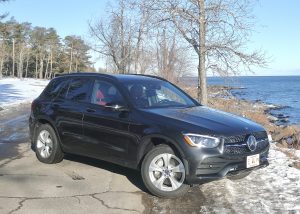
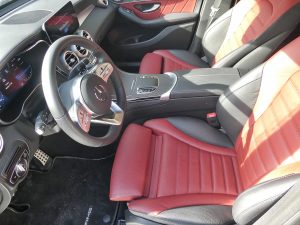


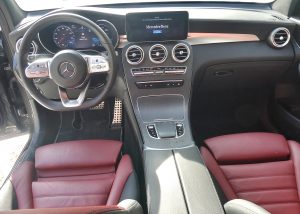
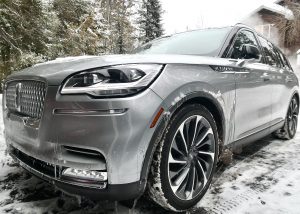


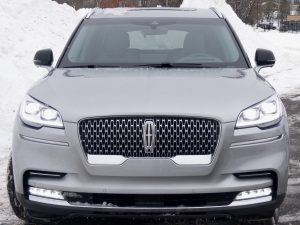
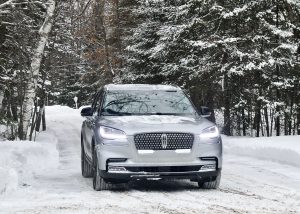
 John Gilbert is a lifetime Minnesotan and career journalist, specializing in cars and sports during and since spending 30 years at the Minneapolis Tribune, now the Star Tribune. More recently, he has continued translating the high-tech world of autos and sharing his passionate insights as a freelance writer/photographer/broadcaster. A member of the prestigious North American Car and Truck of the Year jury since 1993. John can be heard Monday-Friday from 9-11am on 610 KDAL(www.kdal610.com) on the "John Gilbert Show," and writes a column in the Duluth Reader.
John Gilbert is a lifetime Minnesotan and career journalist, specializing in cars and sports during and since spending 30 years at the Minneapolis Tribune, now the Star Tribune. More recently, he has continued translating the high-tech world of autos and sharing his passionate insights as a freelance writer/photographer/broadcaster. A member of the prestigious North American Car and Truck of the Year jury since 1993. John can be heard Monday-Friday from 9-11am on 610 KDAL(www.kdal610.com) on the "John Gilbert Show," and writes a column in the Duluth Reader.